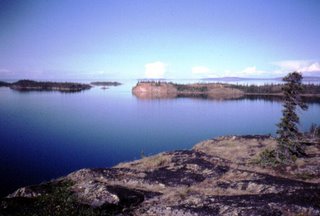 Last week, an agreement was announced between federal officials and first nations for the creation of a vast new national park centred on Great Slave Lake in the Northwest Territories. The proposed park would encompass an area of 33,525 square kilometers - an area four times the size of Yellowstone. Included in the proposed area are 4,000 square kilometers of the lake itself (the world's tenth largest), as well as a key northern landscape representing the transition zone between boreal forest and northern tundra that is home to caribou, moose, grizzlies and black bears.
Last week, an agreement was announced between federal officials and first nations for the creation of a vast new national park centred on Great Slave Lake in the Northwest Territories. The proposed park would encompass an area of 33,525 square kilometers - an area four times the size of Yellowstone. Included in the proposed area are 4,000 square kilometers of the lake itself (the world's tenth largest), as well as a key northern landscape representing the transition zone between boreal forest and northern tundra that is home to caribou, moose, grizzlies and black bears.
The local Lutsel K'e Dene first nations, who negotiated the agreement with the federal government, are proposing to call the new area Thaydene Nene National Park, which means "land of the ancestors" in the Dene language. Like the DeCho first nations of the Nahanni watershed, the threat of mining development was a key consideration in their agreement to support the creation of the park - a stance that has changed since they initially opposed the park's creation 30 years ago.
Formal talks on the creation of the park will now begin, with the expectation that the park boundaries will be ready for parliamentary approval in three years. The last time Canada gained a new national park was 2005 when the federal government signed an agreement with the Labrador Inuit Association for the creation of the Torngat Mountains National Park Reserve in Labrador.
Lưu trữ Blog
-
▼
2006
(731)
-
▼
tháng 10
(94)
- And, They're Off!
- D. Kirby
- Be Afraid!
- Al Gore to Advise UK on Climate Policy
- Global Warming Price Tag - $7 Trillion
- YouTube Video Clips Removed
- 10,000th Hit
- Is This Fair?
- Miss Cooper
- Call for legal copying of own CDs
- Australia Approves World's Largest Solar Plant
- I Count Rally Update
- Bolls
- Playlist - 28th October 2006 - Baked Goods
- Court Ruling: RIAA CAN'T Examine People's Hard Dri...
- The Coach Blog On Your Cellphone
- Green Sell Out Attacks Activist
- Toot Toot, Beep Beep, Yeah!
- Top Ten Consumers of Earth's Resources
- David Suzuki to Step Away from Spotlight
- How to Vote Green in November
- Oil Glutton to Head US Energy Policy
- British Government Tables New Climate Bill
- Why I Didn't Buy an Apple
- Carbon Neutral Oil Sands Possible
- RealClimate Offers Powerful New Search Tool
- Write to Your MP About Deep Integration
- Book A Bitch
- Skittered on the Floor
- The OC Plays Green Card
- Color Infrared
- Awesome third-party Wii controllers
- Deep Integration Update - Does Your MP Give a S#@! ?
- Brits are the EU's Worst Energy Wasters
- Made of Steel
- Our Polar Impacts
- Pics from show
- Playlist - 21st October 2006
- Absolute World
- Google Cheat Sheet (Version 1.02)
- Painting Harper's Political Corner
- Finally decided to be YOURSELF
- Zelda:Twilight Princess for GameCube NOT to be sol...
- A Departure
- Ta Da! Tory Clean Air Plan Unveiled
- Schwarzenegger Joins NE States in Global Warming F...
- Google Goes Solar
- Iceland Begins Commercial Whaling
- Its Official. There's Just Way to Many Americans
- UK Rallying Around Climate Change - Join the Effort
- Canada to Establish a New National Park
- The Black Hole: House-Hunting
- Bucs top Bengals for 1st victory
- Wal-Mart to RIAA: We're not gonna take it!
- Playlist - 14th October 2006 - Funkology
- The Big OE (Part II: Car Buying)
- Thinking of preordering a Wii from Amazon.com? Th...
- A confirmation of Nerf Wiimotes
- Tory Clean Air Act Leaked
- Oil Rich Calgary Hard Over Surging Profits
- Canada's Top CO2 Polluters Exposed
- DuPont Announces $6 Billion Sustainable Strategy
- Romance Isn't What It Use To Be
- Clean Air Pledge Goes Up in Smog
- Some Hope for First Nations Water
- Best & Worst US Elected Officials
- A Formal Affair
- Conservatives Rhetoric Announces An End Of Rhetoric
- Disney-ABC: "We understand piracy now as a busines...
- Skype Founder: Kazaa, Napster Help Music
- The Indie-Rock Insurgency Against iTunes
- BattleStar Galactica going to NBC
- She Demands
- The Big Adventure, Pt I.
- Playlist - 7th October 2006
- Car
- Feds Slammed for Failing to Protect Drinking Water
- Run Rona Run
- British Opposition Calls for Tougher Climate Laws
- George Lucas: Let's Get Small
- Tories Embarrassed as Opposition Passes Climate Bill
- Nicaragua to Saw Country in Half
- Science Idol: Winner of the UCS Cartoon Contest
- She is WoW
- News as it Should Be
- Canada Poised for CO2 Windfall - Federal Leadershi...
- US Population to Hit 300 Million
- Why CD Mastering is Ruining Music
- Save the Earth for the Cost of a Cup of Coffee
- Conservatives Given Climate Change Warning
- If you think charging for HD is OK, you are a cabl...
- It's the Great Pumpkin Porter, Charlie Brown!
- Dub Review - October 2006
- Future of Man
-
▼
tháng 10
(94)